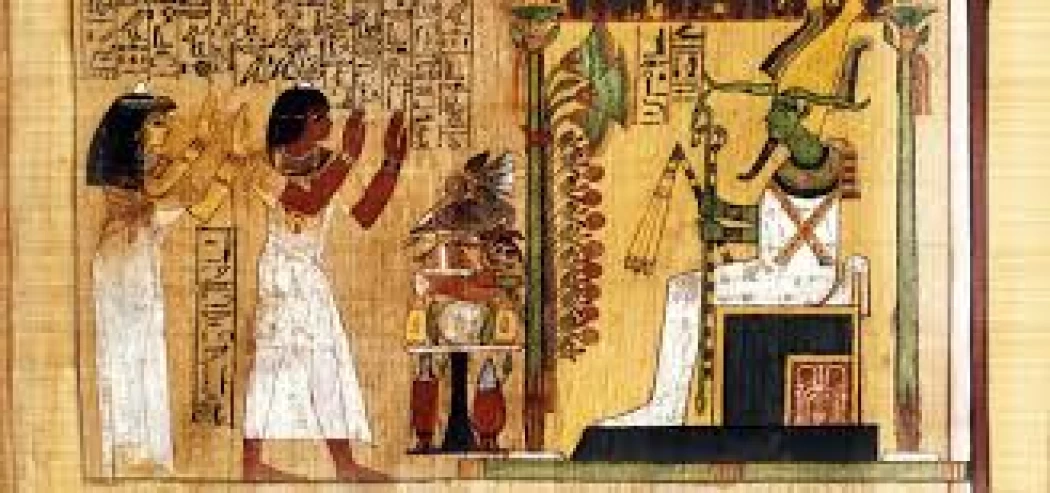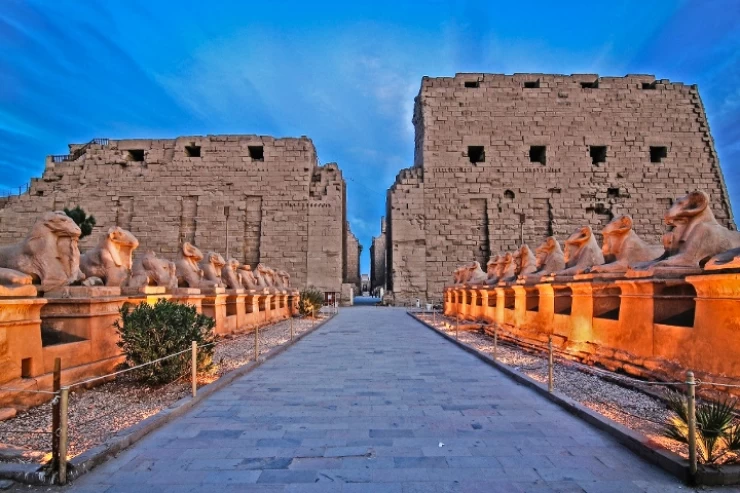
Le livre des morts | Texte funéraire égyptien antique
À l'intérieur se trouvaient des textes funéraires de toutes sortes, à la fois des formules magico-religieuses et des histoires, à l'aide desquels le défunt pouvait surmonter les innombrables épreuves auxquelles il serait confronté sur le long et sinueux chemin qui l'a conduit à la présence d'Osiris. Les textes l'auraient donc aidé à la fois à atteindre le dieu de la mort sans problèmes particuliers et à préparer le soi-disant témoignage de sa vie terrestre, dont l'épreuve appartenait à Osiris.
Le Livre des Morts a pris diverses formes au fil du temps. Au départ, en effet, des formules et des histoires étaient gravées sur les murs de la tombe, pour être gravées directement sur le sarcophage. Au fil du temps et jusqu'à la dix-huitième dynastie (1543-1292 Av. J.-C.), le livre des morts a de nouveau changé de forme: les textes funéraires ont été transférés sur papyrus, puis fermés dans un sarcophage avec le défunt et tous ces objets qui pourraient être utiles dans son dernier voyage.
Ces formules magiques placées dans des tombes, selon les croyances, protégeaient et aidaient le défunt dans le monde souterrain, et elles incluent des hymnes au dieu Amon Rê, le dieu du soleil. On peut voir des descriptions de sorts sur les passages et les murs des tombes, sur les emballages des momies et même à l'intérieur du masque doré du roi Toutankhamon.
Le Livre des Morts est apparu pour la première fois dans le Nouvel Empire, mais son texte a évolué à partir d'une longue histoire d'écriture funéraire magique. Les plus anciens d'entre eux, les Textes des Pyramides, n'étaient accessibles qu'aux Égyptiens. Ensuite, ils ont évolué vers des Textes de Cercueil - une version modifiée des Textes des Pyramides - qui ont été écrits sur des cercueils et inclus dans les tombes de personnes non royales, telles que de riches Égyptiens et des représentants de l'élite.
Osiris était le dieu de la résurrection, et Rê était le dieu soleil, une étoile dans le Livre des Morts. Puis 42 dieux supplémentaires se tournent vers le juge. Bien que le texte lui-même varie en contenu et en ordre, l'histoire est généralement divisée en quatre sections principales: le défunt entre dans le monde souterrain et retrouve les pouvoirs physiques des vivants, le défunt ressuscite et rejoint Rê pour se lever comme le soleil tous les jours, il parcourt le ciel avant le jugement dans le monde souterrain des dieux et, enfin, trouve une âme.
Voyagez en Égypte pour visiter les temples et les pyramides égyptiennes et en apprendre davantage sur la mythologie et les centaines de dieux adorés par les Pharaons, qui ressemblaient beaucoup aux humains, qu'ils aimaient et détestaient, ressentaient de la jalousie, se battaient et mouraient au cours d'un mythe étonnant plein d'événements joyeux, actifs et dramatiques qui ont inspiré les cinéastes et producteurs modernes à créer des films de renommée mondiale sur la grandeur des pharaons et des dieux qu'ils adoraient. Réservez quelques jours pour visiter Abydos, Gizeh, Louxor, Assouan pour voir les tombeaux des pharaons décorés de scènes très claires, détaillées et magnifiquement peintes de diverses divinités de l'Égypte ancienne, ainsi que de nombreux autres lieux, villes, aventures et activités au Caire, Vous pouvez essayer et réservez l'un de nos circuits en Égypte et forfaits touristiques en Égypte de nombreux groupes privés avec un guide Excursions d'une journée au Caire depuis l'aéroport et excursions d'une journée en Égypte pour explorer la capitale de l'Égypte, Le Caire, vous pouvez consulter de nombreux itinéraires en Égypte ou participer à l'une de nos excursions complètes d'une journée au Caire comme:
- Itinéraires touristiques en Egypte / Itinéraires en Egypte.
- Tours à Assouan / Excursions à Assouan / Excursions d'une journée à Assouan / Visites guidées à Assouan.
Inside were funerary texts of various kinds, both magico-religious formulas and stories, with the help of which the deceased could overcome the countless trials that he would face on the long and winding path that led him to the presence of Osiris. The texts, therefore, would have helped him both to reach the god of death without any special problems, and to prepare the so-called testimony of his earthly life, the trial of which belonged to Osiris.
The Book of the Dead has taken various forms over time. Initially, indeed, formulas and stories were engraved on the walls of the tomb, only to be engraved directly on the sarcophagus. Over time and until the eighteenth dynasty (1543-1292 BC), the book of the dead changed its form again: the funeral texts were transferred to papyrus, then closed in a sarcophagus along with the deceased and all those objects that could be useful in his last journey.
These magical formulas placed in tombs, according to beliefs, protected and helped the deceased in the underworld, and they include hymns to the god Amun Re, the god of the sun. We can see descriptions of spells on the passages and walls of tombs, on the wrappers of mummies and even inside the golden mask of King Tutankhamun.
The Book of the Dead first appeared in the New Kingdom, but its text evolved from a long history of magical funeral writing. The most ancient of them, the Pyramid Texts, were accessible only to the Egyptians. Then they evolved to Coffin Texts - a modified version of the Pyramid Texts - which were written on coffins and included in the tombs of non-royal persons, such as rich Egyptians and representatives of the elite.
As for the history of the writing of the Book of the Dead, the Pharaohs wrote down the Book of the Dead during the era of the construction of the Great Pyramid, and a copy of it is still preserved in the British Museum. It contains invocations to the gods, hymns, and prayers. Then there is a description of the reckoning that the souls of the dead encounter in the afterlife and the punishment and reward that befalls them.
The Pharaohs built huge temples in addition to tombs that were no less magnificent and luxurious, as they believed in resurrection and the return of the soul, which they depicted in two close images, "Ka" or "Ba." They were also keen to place all the things related to the deceased, including food, jewelry, and everything he loved in his life, with him in his tomb, where the soul of the deceased could eat and drink from it when it returned to the body, and before seeking the afterlife.
The ancient Egyptians knew religious literature since the dawn of history, and their holy books varied, most of which were about death and the afterlife. Their books usually contained a group of religious texts that expressed the Egyptians' perception of the life of the dead in the afterlife, and included a group of spells that were recited when preparing the body for burial.
Perhaps the ancient Pharaohs amazed the world with the diversity of these texts, and their abundance of ancient religious spells and literature, which remained an icon no less important than the remaining monuments from the Pharaonic eras, such as temples, royal tombs, and obelisks. Among these books' most significant works are:
Book of the Dead
Pyramid texts
The Book of Two Paths
The Guide's Book
Spell No. 125 is one of the most famous texts of the Book of the Dead. Even those unfamiliar with the book, and those unfamiliar with Egyptian mythology, know about the spell without realizing it. It is the incantation describing the trial of the deceased's heart in the Hall of Justice by the god Osiris, and is one of the most famous known images from ancient Egypt, although the god with his scale is not actually described in the text. Given the importance of the deceased passing the test of his heart weight in order to pass into bliss, knowing what to say and how to act in the presence of Osiris, Thoth, Anubis and the forty-two judges was the most important information with which the deceased could reach the afterlife.
After death, Anubis guides the deceased to the Hall of Justice (also known as the Hall of Two Truths), where the deceased will make the Confession of Absolution (also known as the Declaration of Innocence). This Confession of Absolution was a list of forty-two sins that the individual could honestly deny never to commit. Once made, Osiris, Thoth, Anubis, and the Forty-Two Judges consulted.
If the confession was accepted, the deceased's heart was weighed in a balance against the white feather of Maat, the feather of truth. If the deceased's heart was lighter than the feather of Maat, their soul passed to Heaven; if it was heavier than the feather, the heart was thrown to the ground, where it was devoured by the divine monster Ammut, and its owner's soul ceased to exist.
Spell 125 begins with an introduction to the reader (i.e., the soul of the deceased): "What to say upon arrival at the Hall of Justice"















